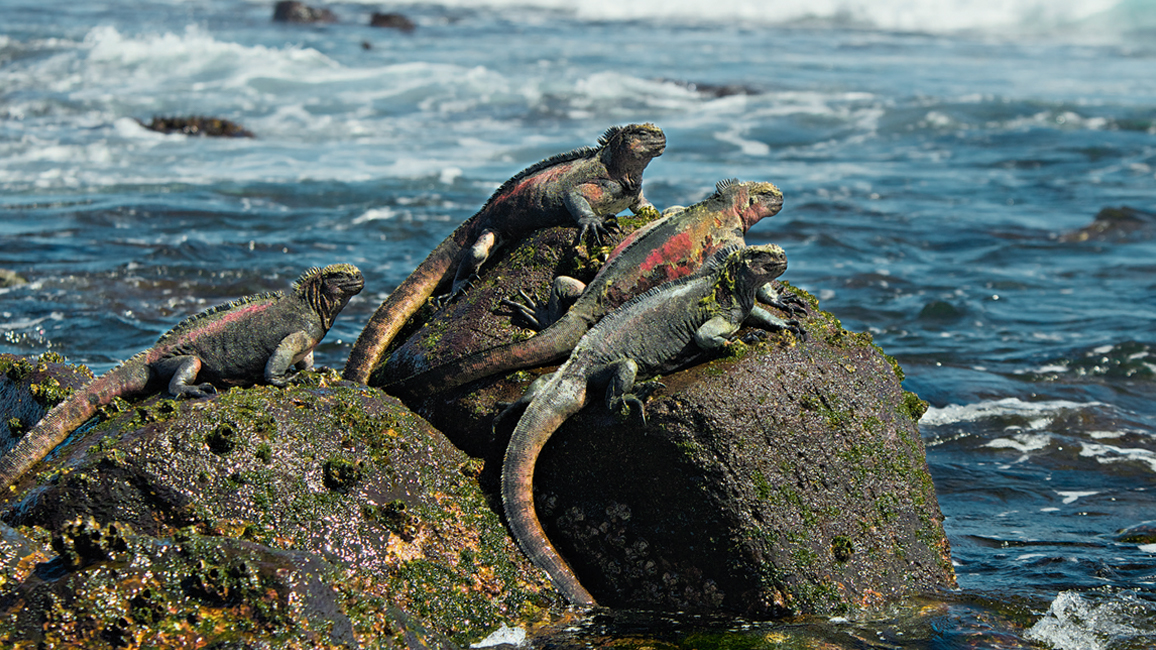
Sea Dragon
By Ellen Lambeth; photos by Tim LamanThis is not science fiction, and the creatures aren’t monsters.
They’re marine iguanas, the world’s only lizards that feed in the sea. And they live only on a tiny cluster of islands, smack dab on the equator. The islands, called the Galápagos (guh-LAH-puh-gohs), are part of the South American country of Ecuador.
Cute? Not So Much!
Marine iguanas might not win any beauty contests. Most of the time, they look like grayish-black lumps on grayish-black rocks. The dark color is great for protecting their skin from the damaging rays of the sun—and also for soaking up its warmth.
As you can see in the photos here, adults may get some color on their scaly skin—but only during breeding season.
That’s also the only time of year that marine iguanas squabble. Males fight other males over mates, butting each other with their knobby heads. And females fight other females over nesting spots. The rest of the year, marine iguanas just live and let live. They also “talk” to each other by raising and lowering those spiny crests on their heads and backs.
At Home in the Sea
Some lizards eat insects or other small animals. Some lizards eat fruits and other plant parts. But marine iguanas are the only lizards that eat mostly seaweed! Every day, they swim out into the cold ocean and dive down to feast. Because of their blunt snouts, they can get their jaws right up against the rocks. Then they scrape off the seaweed with their teeth.
Swimming is no problem for a marine iguana. Its long tail is flattened sideways, so it works well as a paddle. The iguana swishes its tail—and whole body—from side to side to move effortlessly through the water.
Usually, the iguana makes quick dives close to shore to find its food. But it can swim a half-mile out and dive about 65 feet down. It also can stay nearly an hour underwater before coming up for air. Long, strong toes and sharp claws help it hang on to slippery rocks, even in crashing waves.
A marine iguana also has a special way of dealing with all the salt it swallows when feeding underwater. Glands in the nose collect the extra salt. When they get full, the iguana squirts a salty spray out its nostrils. It might even aim the spray at an attacker—such as a Galápagos hawk—to scare it off. But usually not much bothers these big lizards. One can grow to be three to five feet long—or more!
Weird History
No one is sure where these seagoing lizards came from. The Galápagos Islands formed from underwater volcanoes several million years ago.
As the lava cooled off and broke down to form soil, plant seeds from other lands drifted in on the winds or waves and took root. Gradually, birds and insects flew in or were blown in. But how did bigger animals get there?
Some scientists think the marine iguanas may have gotten their start from land iguanas living in other places. Here’s how: During storms, some iguanas may have drifted to the new islands on floating clumps of sticks, leaves, and mud. Over many thousands of years, these seaside iguanas evolved to become today’s one-of-a-kind marine iguanas of the Galápagos.
“Sea Dragon” originally appeared in the September 2015 issue of Ranger Rick magazine.
(Click on each image above for a closer view of the story.)


















